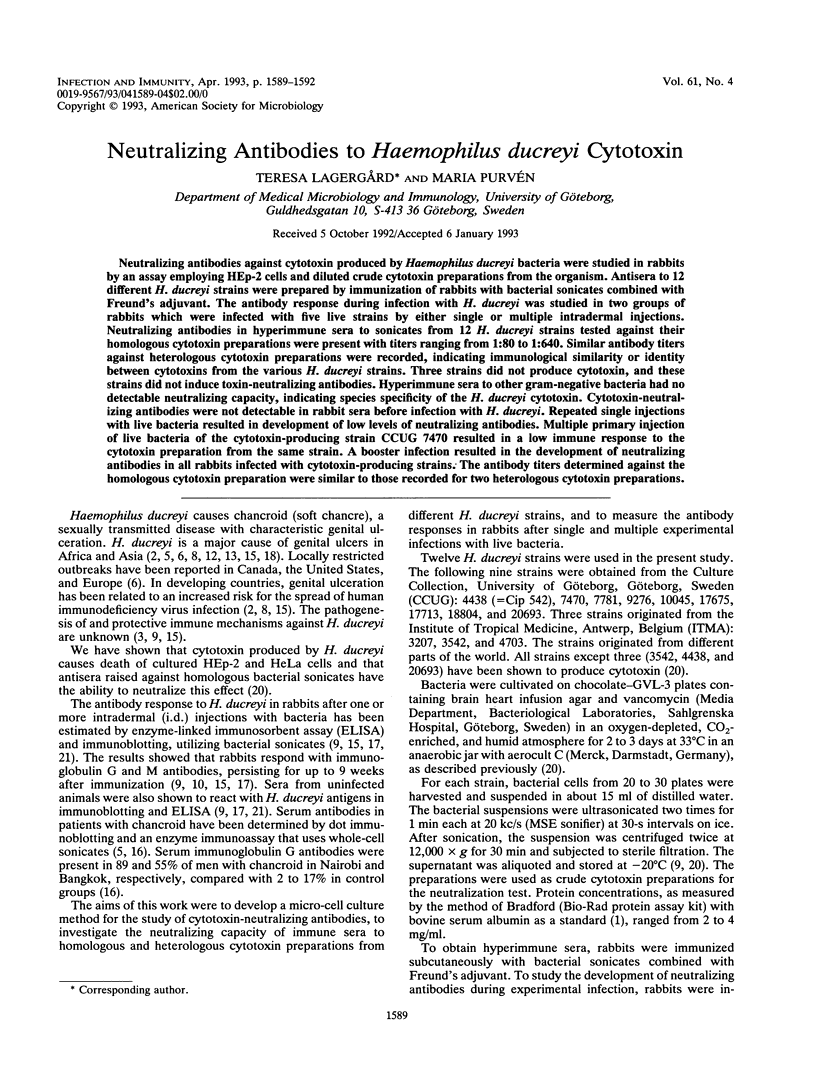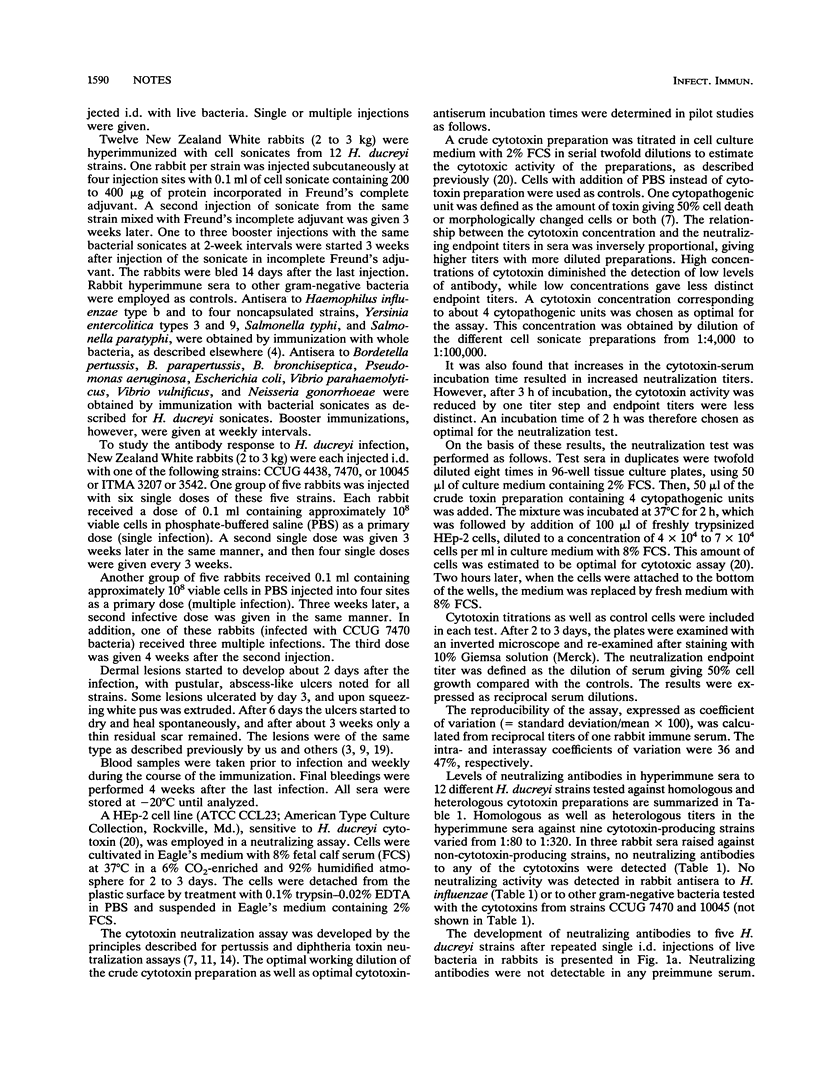Abstract
Neutralizing antibodies against cytotoxin produced by Haemophilus ducreyi bacteria were studied in rabbits by an assay employing HEp-2 cells and diluted crude cytotoxin preparations from the organism. Antisera to 12 different H. ducreyi strains were prepared by immunization of rabbits with bacterial sonicates combined with Freund's adjuvant. The antibody response during infection with H. ducreyi was studied in two groups of rabbits which were infected with five live strains by either single or multiple intradermal injections. Neutralizing antibodies in hyperimmune sera to sonicates from 12 H. ducreyi strains tested against their homologous cytotoxin preparations were present with titers ranging from 1:80 to 1:640. Similar antibody titers against heterologous cytotoxin preparations were recorded, indicating immunological similarity or identity between cytotoxins from the various H. ducreyi strains. Three strains did not produce cytotoxin, and these strains did not induce toxin-neutralizing antibodies. Hyperimmune sera to other gram-negative bacteria had no detectable neutralizing capacity, indicating species specificity of the H. ducreyi cytotoxin. Cytotoxin-neutralizing antibodies were not detectable in rabbit sera before infection with H. ducreyi. Repeated single injections with live bacteria resulted in development of low levels of neutralizing antibodies. Multiple primary injection of live bacteria of the cytotoxin-producing strain CCUG 7470 resulted in a low immune response to the cytotoxin preparation from the same strain. A booster infection resulted in the development of neutralizing antibodies in all rabbits infected with cytotoxin-producing strains. The antibody titers determined against the homologous cytotoxin preparation were similar to those recorded for two heterologous cytotoxin preparations.
Full text
PDF



Selected References
These references are in PubMed. This may not be the complete list of references from this article.
- Bradford M. M. A rapid and sensitive method for the quantitation of microgram quantities of protein utilizing the principle of protein-dye binding. Anal Biochem. 1976 May 7;72:248–254. doi: 10.1016/0003-2697(76)90527-3. [DOI] [PubMed] [Google Scholar]
- Campagnari A. A., Wild L. M., Griffiths G. E., Karalus R. J., Wirth M. A., Spinola S. M. Role of lipooligosaccharides in experimental dermal lesions caused by Haemophilus ducreyi. Infect Immun. 1991 Aug;59(8):2601–2608. doi: 10.1128/iai.59.8.2601-2608.1991. [DOI] [PMC free article] [PubMed] [Google Scholar]
- Dahlberg T., Branefors P. Enzyme-linked immunosorbent assay for titration of Haemophilus influenzae capsular and O antigen antibodies. J Clin Microbiol. 1980 Aug;12(2):185–192. doi: 10.1128/jcm.12.2.185-192.1980. [DOI] [PMC free article] [PubMed] [Google Scholar]
- Dangor Y., Fehler G., Exposto F. D., Koornhof H. J. Causes and treatment of sexually acquired genital ulceration in southern Africa. S Afr Med J. 1989 Oct 7;76(7):339–341. [PubMed] [Google Scholar]
- De Schryver A., Meheus A. Epidemiology of sexually transmitted diseases: the global picture. Bull World Health Organ. 1990;68(5):639–654. [PMC free article] [PubMed] [Google Scholar]
- Gillenius P., Jätmaa E., Askelöf P., Granström M., Tiru M. The standardization of an assay for pertussis toxin and antitoxin in microplate culture of Chinese hamster ovary cells. J Biol Stand. 1985 Jan;13(1):61–66. doi: 10.1016/s0092-1157(85)80034-2. [DOI] [PubMed] [Google Scholar]
- Kreiss J. K., Koech D., Plummer F. A., Holmes K. K., Lightfoote M., Piot P., Ronald A. R., Ndinya-Achola J. O., D'Costa L. J., Roberts P. AIDS virus infection in Nairobi prostitutes. Spread of the epidemic to East Africa. N Engl J Med. 1986 Feb 13;314(7):414–418. doi: 10.1056/NEJM198602133140704. [DOI] [PubMed] [Google Scholar]
- Lagergård T. The role of Haemophilus ducreyi bacteria, cytotoxin, endotoxin and antibodies in animal models for study of chancroid. Microb Pathog. 1992 Sep;13(3):203–217. doi: 10.1016/0882-4010(92)90021-f. [DOI] [PubMed] [Google Scholar]
- Lagergård T., Trollfors B., Claesson B. A., Karlberg J., Taranger J. Determination of neutralizing antibodies and specific immunoglobulin isotype levels in infants after vaccination against diphtheria. Eur J Clin Microbiol Infect Dis. 1992 Apr;11(4):341–345. doi: 10.1007/BF01962074. [DOI] [PubMed] [Google Scholar]
- Meheus A., Van Dyck E., Ursi J. P., Ballard R. C., Piot P. Etiology of genital ulcerations in Swaziland. Sex Transm Dis. 1983 Jan-Mar;10(1):33–35. doi: 10.1097/00007435-198301000-00007. [DOI] [PubMed] [Google Scholar]
- Miyamura K., Tajiri E., Ito A., Murata R., Kono R. Micro cell culture method for determination of diphtheria toxin and antitoxin titres using VERO cells. II. Comparison with the rabbit skin method and practical application for seroepidemiological studies. J Biol Stand. 1974 Jul;2(3):203–209. doi: 10.1016/0092-1157(74)90016-x. [DOI] [PubMed] [Google Scholar]
- Morse S. A. Chancroid and Haemophilus ducreyi. Clin Microbiol Rev. 1989 Apr;2(2):137–157. doi: 10.1128/cmr.2.2.137. [DOI] [PMC free article] [PubMed] [Google Scholar]
- Museyi K., Van Dyck E., Vervoort T., Taylor D., Hoge C., Piot P. Use of an enzyme immunoassay to detect serum IgG antibodies to Haemophilus ducreyi. J Infect Dis. 1988 May;157(5):1039–1043. doi: 10.1093/infdis/157.5.1039. [DOI] [PubMed] [Google Scholar]
- Müller F., Müller K. H. Immunoglobulin M and G antibody response in rabbits after experimental Haemophilus ducreyi infection. Zentralbl Bakteriol Mikrobiol Hyg A. 1988 Apr;268(2):238–244. doi: 10.1016/s0176-6724(88)80008-7. [DOI] [PubMed] [Google Scholar]
- Nsanze H., Fast M. V., D'Costa L. J., Tukei P., Curran J., Ronald A. Genital ulcers in Kenya. Clinical and laboratory study. Br J Vener Dis. 1981 Dec;57(6):378–381. doi: 10.1136/sti.57.6.378. [DOI] [PMC free article] [PubMed] [Google Scholar]
- Purcell B. K., Richardson J. A., Radolf J. D., Hansen E. J. A temperature-dependent rabbit model for production of dermal lesions by Haemophilus ducreyi. J Infect Dis. 1991 Aug;164(2):359–367. doi: 10.1093/infdis/164.2.359. [DOI] [PubMed] [Google Scholar]
- Purvén M., Lagergård T. Haemophilus ducreyi, a cytotoxin-producing bacterium. Infect Immun. 1992 Mar;60(3):1156–1162. doi: 10.1128/iai.60.3.1156-1162.1992. [DOI] [PMC free article] [PubMed] [Google Scholar]
- Saunders J. M., Folds J. D. Immunoblot analysis of antigens associated with Haemophilus ducreyi using serum from immunised rabbits. Genitourin Med. 1986 Oct;62(5):321–328. doi: 10.1136/sti.62.5.321. [DOI] [PMC free article] [PubMed] [Google Scholar]


